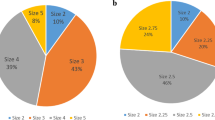Abstract
Introduction and hypothesis
We compared the outcomes of women who underwent laparoscopic lateral suspension with concurrent total laparoscopic hysterectomy (LLS-TLH) with those of women who underwent laparoscopic sacrocolpopexy with concurrent total laparoscopic hysterectomy (LSC-TLH) for apical and/or anterior vaginal wall prolapse.
Methods
Eighty women underwent LLS-TLH or LSC-TLH operations. According to the Pelvic Organ Prolapse Quantification System (POP-Q), women with symptomatic pelvic organ prolapse of stage 2 or higher apical and/or anterior compartment prolapse were enrolled in the study. The objective cure rate according to the POP-Q system was the primary (objective) outcome. The International Consultation on Incontinence Questionnaire-Vaginal Symptoms (ICIQ-VS), International Consultation on Incontinence Questionnaire-Short Form (ICIQ-SF), and Patient Global Impression of Improvement (PGI-I) questionnaire scores were the secondary (subjective) outcomes. The primary and secondary outcomes were evaluated at 1 year after surgery.
Results
The primary and secondary outcomes indicated significant improvements in both groups (p < 0.05). The objective cure rate was 92.5% for apical and 78.6% for anterior compartment prolapse in the LLS-TLH group; the respective rates were 100% and 74.1% in the LSC-TLH group. The subjective cure rate was 87.5% for the LLS-TLH group and 90% for the LSC-TLH group. No statistically significant differences between groups were found in the objective cure rate, subjective cure rate, or ICIQ-VS, ICIQ-SF, or PGI-I scores at 1 year (p > 0.05).
Conclusions
LLS-TLH can serve as a safe, effective, and feasible alternative to LSC-TLH, with low complication rates and similar short-term objective and subjective outcomes.

Similar content being viewed by others
References
Barber MD, Maher C. Apical prolapse. Int Urogynecol J. 2013;24:1815–33.
Olsen AL, Smith VJ, Bergstrom JO, et al. Epidemiology of surgically managed pelvic organ prolapse and urinary incontinence. Obstet Gynecol. 1997;89:501–6.
De Sa DG, M, Claydon LS, Whitlow B, Dolcet Artahona MA. Laparoscopic versus open sacrocolpopexy for treatment of prolapse of the apical segment of the vagina: a systematic review and meta-analysis. Int Urogynecol J. 2016;27:3–17. https://doi.org/10.1007/s00192-015-2765-y.
Unger CA, Paraiso MF, Jelovsek JE, Barber MD, Ridgeway B. Perioperative adverse events after minimally invasive abdominal sacrocolpopexy. Am J Obstet Gynecol. 2014;211(547):e1–8. https://doi.org/10.1016/j.ajog.2014.07.054.
Dubuisson JB, Chapron C. Laparoscopic iliac colpouterine suspension for treatment of genital prolapse using two meshes. A new operative technique. Journal of. Gynecol Surg. 1998;14:153–9.
Dubuisson JB, Jacob S, Chapron C, Fauconnier A, Decuypere F, Dubernard G. Laparoscopic treatment of genital prolapse: lateral utero-vaginal suspension with 2 meshes. Results of a series of 47 patients. Gynecol Obstet Fertil. 2002;30:114–20.
Dubuisson JB, Eperon I, Jacob S, et al. Laparoscopic repair of pelvic organ prolapse by lateral suspension with mesh: a continuous series of 218 patients. Gynecol Obstet Fertil. 2011;39:127–31.
Dubuisson J, Eperon I, Dällenbach P, Dubuisson JB. Laparoscopic repair of vaginal vault prolapse by lateral suspension with mesh. Arch Gynecol Obstet. 2013;287:307–12. https://doi.org/10.1007/s00404-012-2574-1.
Veit-Rubin N, Dubuisson JB, Lange S, Eperon I. Dubuisson Uterus-preserving laparoscopic lateral suspension with mesh for pelvic organ prolapse: a patient-centred outcome report and video of a continuous series of 245 patients. Int Urogynecol J. 2016;27:491–3. https://doi.org/10.1007/s00192-015-2859-6.
Veit-Rubin N, Dubuisson JB, Gayet-Ageron A, Lange S, Eperon I, Dubuisson J. Patient satisfaction after laparoscopic lateral suspension with mesh for pelvic organ prolapse: outcome report of a continuous series of 417 patients. Int Urogynecol J. 2017;28:1685–93.
Veit-Rubin N, Dubuisson J, Constantin F, et al. Uterus preservation is superior to hysterectomy when performing laparoscopic lateral suspension with mesh. Int Urogynecol J. 2019;30:557–64.
Mereu L, Tateo S, D'Alterio MN, et al. Laparoscopic lateral suspension with mesh for apical and anterior pelvic organ prolapse: A prospective double center study. Eur J Obstet Gynecol Reprod Biol. 2020;244:16–20.
Dällenbach P, De Oliveira SS, Marras S. Boulvain M Incidence and risk factors for mesh erosion after laparoscopic repair of pelvic organ prolapse by lateral suspension with mesh. Int Urogynecol J. 2016;27:1347–55. https://doi.org/10.1007/s00192-016-2974-z.
Stepanian AA, Miklos JR, Moore RD, Mattox TF. Risk of mesh extrusion and other mesh-related complications after laparoscopic sacral colpopexy with or without concurrent laparoscopic-assisted vaginal hysterectomy: experience of 402 patients. J Minim Invasive Gynecol. 2008;15:188–96.
Swift S, Morris S, McKinnie V, et al. Validation of a simplified technique for using the POPQ pelvic organ prolapse classification system. Int Urogynecol J Pelvic Floor Dysfunct. 2006;17:615–20.
Barber MD, Brubaker L, Nygaard I, et al. Defining success after surgery for pelvic organ prolapse. Obstet Gynecol. 2009;114:600–9.
Price N, Jackson SR, Avery K, Brookes ST, Abrams P. Development and psychometric evaluation of the ICIQ Vaginal Symptoms Questionnaire: the ICIQ-VS. BJOG. 2006;113:700–12.
Avery K, Donovan J, Peters TJ, Shaw C, Gotoh M, Abrams P. ICIQ: a brief and robust measure for evaluating the symptoms and impact of urinary incontinence. Neurourol Urodyn. 2004;23:322–30.
Srikrishna S, Robinson D, Cardozo L. Validation of the Patient Global Impression of Improvement (PGI-I) for urogenital prolapse. Int Urogynecol J. 2010;21:523–8.
Clavien PA, Barkun J, de Oliveira ML, Vauthey JN, Dindo D, Schulick RD, et al. The Clavien-Dindo classification of surgical complications: five-year experience. Ann Surg. 2009;250(2):187–96.
Pan K, Cao L, Ryan NA, Wang Y, Xu H. Laparoscopic sacral hysteropexy versus laparoscopic sacrocolpopexy with hysterectomy for pelvic organ prolapse. Int Urogynecol J. 2016;27:93–101.
Costantini E, Brubaker L, Cervigni M, et al. Sacrocolpopexy for pelvic organ prolapse: evidence-based review and recommendations. Eur J Obstet Gynecol Reprod Biol. 2016;205:60–5.
Author information
Authors and Affiliations
Contributions
All authors participated in the manuscript.
Corresponding author
Ethics declarations
Conflicts of interest
None.
Additional information
Publisher’s note
Springer Nature remains neutral with regard to jurisdictional claims in published maps and institutional affiliations.
Supplementary information
(MP4 162975 kb)
Rights and permissions
About this article
Cite this article
Isenlik, B.S., Aksoy, O., Erol, O. et al. Comparison of laparoscopic lateral suspension and laparoscopic sacrocolpopexy with concurrent total laparoscopic hysterectomy for the treatment of pelvic organ prolapse: a randomized controlled clinical trial. Int Urogynecol J 34, 231–238 (2023). https://doi.org/10.1007/s00192-022-05267-6
Received:
Accepted:
Published:
Issue Date:
DOI: https://doi.org/10.1007/s00192-022-05267-6




